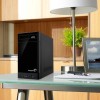Seagate STBN100 Seagate Business Storage 1-Bay, 2-Bay, and 4-Bay NAS Administr - Page 38
group account, hot-swap, HTTP (Hypertext Transfer Protocol)
 |
View all Seagate STBN100 manuals
Add to My Manuals
Save this manual to your list of manuals |
Page 38 highlights
Glossary group account In NAS Manager, a collection of user accounts grouped together to make it faster and easier to manage access to shares. All users in a group have the same level of access to any particular share. See also user account. hot-swap To remove and replace a disk drive without first powering off the server. HTTP (Hypertext Transfer Protocol) Rules for exchanging the most common form of documents (hypertext documents) over the Internet. HTTPS (Hypertext Transfer Protocol over Secure Socket Layer) Rules for exchanging HTTP documents over encrypted connections. JBOD Just a Bunch of Drives. See span. IP address The identifier of a computer, server, or other device on a TCP/IP network. IP addresses are a sequence of four numbers separated by periods. (For example, 123.456.78.1.) Every device on your local network has a unique IP address. IP filters The ability to allow or deny access to a Seagate NAS based on an IP address. global access The ability to remotely access content stored on a Seagate NAS from a web browser or from a supported mobile device application. local access Access to the server from a computer on your local network. Or, manual access to the server, which involves physical contact with the server or its cables. mirror A level of RAID protection also known as RAID 1. A mirror is built from two disk drives, where one disk drive is a mirror of the other (the same data is stored on each disk drive). Compared to independent disk drives, a mirrored volume provides faster performance, but has only 50% of the capacity. NFS Network File System. An application that lets all users on a network share files that are stored on different types of computers. Seagate Business Storage NAS Administrator Guide 38














